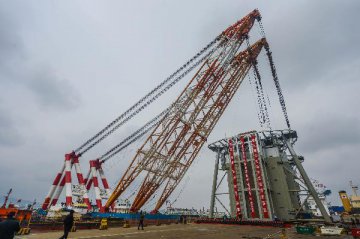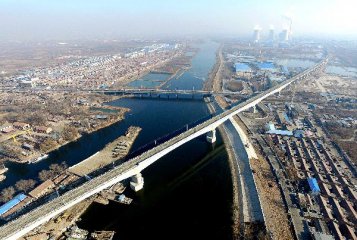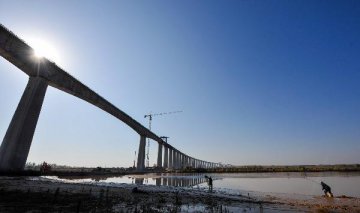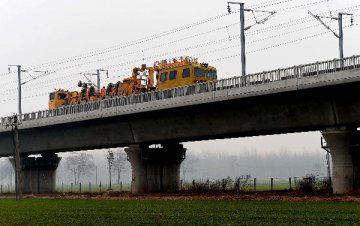
The inspectorate team sent by the State Council to 18 provinces will set off this week to review implementation of policy advancing private investment. This move is not so common.
Growth rate of private investment drops greatly
According to statistics released by the National Bureau of Statistics (NBS) on May 14, the growth in private fixed-asset investment registered 5.2 percent year on year during January-April, declining by 0.5 percentage point from that in January-March. This is the fourth consecutive month that the growth in private investment has dropped and tumbled drastically when compared with 12.7 percent increase during the same period of last year.
Since statistics of private investment were recorded in 2012, private investment usually sees a growth little higher than that of total social investment. Its proportion in the total social investment moves up year by year and reaches about 64 percent at the highest.
But the trend began to polarize in 2016. The total social investment growth started to get stabilized and recover gradually, while private investment growth fell all the way, down from 10.1 percent in late 2015 to 5.2 percent in April this year. Meanwhile, the proportion of private investment in total social investment slipped violently to 62.1 percent during January-April, down by 3.2 percentage points during the same period of last year.
Regarding this change, Lian Ping, chief economist at Bank of Communications, stated in a SSN’s interview that “as private investment is mainly made in manufacturing field, the slowing growth in private investment may have something to do with the sluggish manufacturing”.
Statistics from the NBS show that manufacturing investment accounts for more than 45 percent in private investment and investment amount in manufacturing field recorded 3.74 trillion yuan in January-April with the growth rate down by 0.9 percentage point to 5.4 percent.
The official interpretation of the NBS mentioned three influential elements, including sluggish market demand, enterprises’ weak intention in investment and market access limitation. The NBS claimed that “due to the huge aggregate amount of private investment, the continuous decline in its growth rate will prevent investment from going up stably, to which high attention should be paid.”
In spite of continuous decrease in private investment, growth rate of fixed-asset investment by state-owned enterprises (SOEs) or companies controlled by SOEs soared from 10.9 percent at the end of 2015 to 23.7 percent.
Lian analyzed that it is inevitable that growth rate of investment made by SOEs accelerates as the country increases investment in infrastructure construction this year, which is basically dominated by the SOEs. At present, the growth of infrastructure construction investment is 19 percent, much higher than that of total social investment and manufacturing investment.
“Private investment is more sensitive to the economic changes. This round of economic recovery is mainly driven by policy; therefore, what we can see is a significant rebound in investment of SOEs, but impetus for endogenous growth of real economy is still insufficient, making it hard to stimulate private enterprises’ investment enthusiasm.” Zhang Jun, chief economist from Morgan Stanley Huaxin Securities told the journalist from SSN.
In the opinion of Zhang, relevant liquidity and policy support behind this round of economic recovery are out of reach of ordinary private enterprises and they still need to face some difficulties such as financing problems, high financing cost and high access threshold for some industries, which causes private investment to slide severely.
Proportion of private investment in tertiary industry declines rapidly
Industries with overcapacity like iron & steel and coal see rapid declining investment with the total decline in the first four months aggregating over 20 percent. In contrast, vehicle manufacturing, power, heat production, supply service and other industries see an increase of over 20 percent in investment.
It is noteworthy that for industries facing overcapacity and rapid decline of investment, both private investment and non-private investment decline rapidly, but the proportion of private investment actually rises instead and state-owned investment does not rush to these industries.
However, private investment and non-private investment are seriously polarized in the tertiary industry. Research team of Industrial Securities Co., Ltd. (601377.SH) points out that some industries engaged in public services, such as water and power supply, public management and water conservancy construction, see the most rapid decline of private investment.
A possible explanation, according to the research team, is that the declining proportion of private investment in recent period shows that there are fewer and fewer projects with high yield that can appeal to private investment under economic downward pressure. Along with the completion of infrastructure projects invested by private enterprises under Build-Transfer (BT) and Build-Operate-Transfer (BOT) modes, more and more infrastructure capital comes from government.
Such saying is agreed by insider of Public Private Partnership (PPP). The insider remarked that as an important way to drive private investment, the actual implementation rate of PPP is not high. “Many PPP projects are long in cycle, and will run for a decade and even decades. Some unexpected changes might occur amid the process. Policy changes by local government, far-lower-than-expected yield rate of projects and etc. might leave the projects unfinished. As a result, social capital keeps away from PPP projects.”
The journalist finds through public material that contrasting with frequent launch of PPP demonstration projects in various places in previous two years, not many such projects are launched this year, and only Zhejiang province, Hebei province, Jiangxi province and Hunan province have introduced PPP projects.
Inspectorate teams will soon take actions
The decline of private investment has attracted attention of top management. The executive meeting of the State Council, held on May 4, decided to carry out special inspection over the implementation of policies propelling private placement, and strive to expand private placement. The General Office of the State Council released official notice five days later claiming that the State Council will dispatch nine inspectorate teams to 18 provinces to carry out field inspection, and organize the third-party assessment and special investigation.
It is learnt that besides importance attached to implementation, the inspectorate teams dispatched by the State Council will also focus on relaxing market access for private investment, improving governmental administration service, creating an investment environment with fair competition, striving to propel the development of private investment involved in innovation and entrepreneurship, reinforcing financial support to private investment, advancing PPP mode and etc.
Tong Zaijun, deputy director of the PPP Research Center of Guoxin Tendering Group, remarked during the interview by SSN that the special inspection carried out by the State Council actually reassures enterprises. Private capital is highly motivated, and the key point is to achieve breakthroughs in financing channels. In the meantime, local governments should provide good projects and enable private capital to compete with each other in a fair market environment. After all, social capital always seeks for profit.”
Translated by Jennifer Lu & Vanessa Chen
























Latest comments